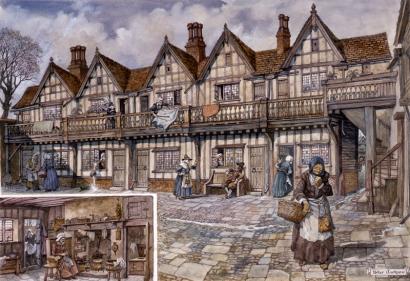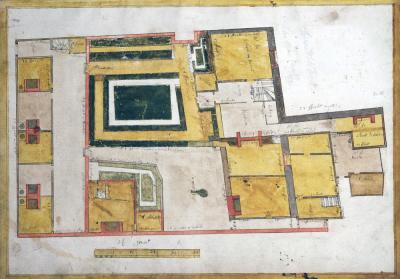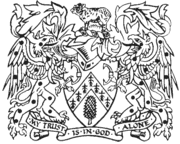Margaret, Countess of Kent granted her interest in an almshouse at Whitefriars to The Clothworkers’ Company by indenture in 1538. [1] She gave further expression to this intention in her will in 1540.[2] Under the terms of the indenture, The Clothworkers’ Company agreed to maintain the almshouse at Whitefriars, and to ensure that seven poor women of the Company occupied the seven rooms, with a pension of seven and a half pence per week.[3] The property consisted of the almshouse and possibly, two small tenements within the ground, which were leased to both the Company porter and another tenant at all times.
 The Countess had gained her interest in the almshouse in a joint indenture between her and The Clothworkers’ Company with the Carmelite Friary of Whitefriars at Thames Street in 1537.[4] The indenture gave the Countess and the Company full control of a garden plot and almshouses, which the Countess had already built, on the site of the Friary’s Scholar’s garden. This site was also called ‘the Coke’.[5] The Countess and the Company’s indenture gave them a ninety-nine year lease of the property, at a rent of ten shillings a year.[6] Under its terms, the almshouse was to be allowed full access to the gardens and water supplies of the friary, while the Countess and the Company undertook to repair the almshouse and to ensure its continual occupation by almswomen.[7] The indenture included the clause that should the almshouse remain empty or fall into decay for a period of more than three years, then the prior of the friary could repossess it, and rent it to another party. Once the ninety-nine year term had been reached, the Company were also to have first call on taking the lease of the property again under the same terms.[8]
The Countess had gained her interest in the almshouse in a joint indenture between her and The Clothworkers’ Company with the Carmelite Friary of Whitefriars at Thames Street in 1537.[4] The indenture gave the Countess and the Company full control of a garden plot and almshouses, which the Countess had already built, on the site of the Friary’s Scholar’s garden. This site was also called ‘the Coke’.[5] The Countess and the Company’s indenture gave them a ninety-nine year lease of the property, at a rent of ten shillings a year.[6] Under its terms, the almshouse was to be allowed full access to the gardens and water supplies of the friary, while the Countess and the Company undertook to repair the almshouse and to ensure its continual occupation by almswomen.[7] The indenture included the clause that should the almshouse remain empty or fall into decay for a period of more than three years, then the prior of the friary could repossess it, and rent it to another party. Once the ninety-nine year term had been reached, the Company were also to have first call on taking the lease of the property again under the same terms.[8]
Following the Countess’ bequest, the Company maintained firm control of the property. In a similar manner to the Company’s other properties, the Company surveyed the property annually to establish if any repairs were needed. The 1554 survey provides the first description of the property following the Countess’ death. At this point, the surveyors reported that the almshouse ‘[lacked] tiling’ and that the ‘windows there be so great that they cannot be lifted up and down and must therefore be cut in the middle, so they can be opened’.[9] By 1562, the major concern of the surveyors related to the need to pave the courtyard, and also to build a sink, for proper drainage of wastewater from the almshouse.[10] The Company continued to make improvements to the property during the late sixteenth century. In 1565, for example, the castle end of the almshouses was weather boarded.[11] In 1576, the Company ordered that the common sink be repaired, as the water remained stagnant in it to the annoyance of the almshouse, and presumably, the detriment of their health.[12]
The Company maintained a firm hold over the replacement and naming of almswomen for Whitefriars. The death of almswomen and their replacement by other poor women under the same terms are recorded each year in the Company Court Orders. The naming of almswomen for the reversion of an almswoman place is also common. The strict regulation of occupancy also meant that the Company made requests for the avoidance of tenants from the property on numerous occasions. In 1565, for example, the Company named Widow James as the replacement for an almswomen who ‘had been diverse times complained on for misrule’ and ‘shall be expulsed’.[13] Similarly, in 1577, the Company evicted the almswoman, Mrs. Scott from Whitefriars for her ‘leud behaviour’ with the Company’s porter there, James Graunt.[14] The Company evicted three widows, Thurlow, Durham and Hill, in 1649, for not actually being free of the Company.[15]
The Clothworkers’ Company also granted rooms in the almshouse to Company pensioners. In 1614, Mrs. Gibson was offered the next avoidance of any place at Whitefriars, with the proviso that her current pension of twenty shillings would cease on entry. Furthermore, the Company also allowed help for old and infirm almswomen to be brought in from outside. In 1616, the Company admitted Elizabeth Phillipps, a widow, to the almshouse to care for Joan Hall, who was ‘lying sick and [could not] help herself’.[16] The Company continued to make the weekly pension payments to the almswomen. These were increased in 1681 with the addition of 4 ½ d. per week to the almswomen’s funds from the rents of the All Hallows Lane properties given by William Gardiner.[17]
at Whitefriars, with the proviso that her current pension of twenty shillings would cease on entry. Furthermore, the Company also allowed help for old and infirm almswomen to be brought in from outside. In 1616, the Company admitted Elizabeth Phillipps, a widow, to the almshouse to care for Joan Hall, who was ‘lying sick and [could not] help herself’.[16] The Company continued to make the weekly pension payments to the almswomen. These were increased in 1681 with the addition of 4 ½ d. per week to the almswomen’s funds from the rents of the All Hallows Lane properties given by William Gardiner.[17]
By the 1640s, a dispute had arisen relating to access arrangements for the houses within the grounds of the almshouse. In 1645, the Company engaged a lawyer, Mr. Lightfoot to help resolve a dispute regarding a passage through the almshouse yard that was demanded by the tenant of the leaseholder, Mr. Macready.[18] Mr. Lightfoot informed the Company that the tenant did in fact have a right to passageway. As a result, the Company put a new lock on the gate and gave a key to both the tenant and the almshouse.[19]
The Clothworkers’ Company purchased the Whitefriars’ property in 1654.[20] The Company set about repairing the property almost immediately after their purchase. In August 1655, they appointed a carpenter and bricklayer to decide on the necessary repairs to the property.[21] By January 1656, a plasterer had also been engaged to amend several rooms in the almshouse.[22] The Company also continued to develop and expand the property. In 1657, they purchased a small piece of ground to the north side of the house from Mrs. Caples.[23] The purchase, however, led to a long dispute with Caples regarding a continued encroachment by her and her tenants on the Company lands.[24] By 1680, the Company were considering building on open land behind the almshouse.[25] In 1687, the Company granted a request from their tenant, who was a neighbour of the almshouse, to allow him a small part of the almswomen’s garden to lengthen his bowling ground. [26]
The Company maintained the almshouse at Whitefriars until 1770, when they built eight tenements at Islington to replace them.[27] The property was noted as the ‘Whitefriar’s Glassworks’ in the nineteenth century, before it was sold in 1879.[28] The Whitefriars property was noted extensively in the Company accounts. Taken at twenty year intervals the monies accrued from the property can be noted. In 1600, the Company received a rental income of £5 from Whitefriars.[29] The annual expenditure on the property was £26 16s. 9d.[30] In 1620, the annual rental income from Whitefriars was 5s, while the expenditure was £15 7s 10d.[31] In 1640, the annual income from Whitefriars was £14 6s. 8d.[32] By 1660, the annual income was £30, with expenditure reaching £14.[33] By 1680 the Company were receiving £14 annually from Whitefriars. Their annual Whitefriars expenses in this year amounted to £13.[34]
Individuals associated with this property
- Isabell Barnes, Occupier, 3-12-1549. Document reference: CL/b/1/1/f. 158v
- Isabell Barnes, Occupier, 16-4-1550. Document reference: CL/b/1/1/f. 161r
- - Caple, Occupier, 19-10-1659. Document reference: CL/b/1/9/f. 131r
- - Caples, Leaseholder, 11-4-1661. Document reference: CL/b/1/9/f. 168v
- - Caples, Seller, 8-7-1657. Document reference: CL/b/1/9/f. 92v
- Ann Conoway, Occupier, 26-6-1668. Document reference: CL/b/1/10/p. 111-112
- - Coples, Leaseholder, 29-5-1661. Document reference: CL/b/1/9/f. 170v
- Richard Corbet, Late occupier, 18-1-1660. Document reference: CL/b/1/9/f. 135r
- Richard Corbett, Late occupier, 17-8-1657. Document reference: CL/b/1/9/f. 96r
- Richard Corbett, Leaseholder, 25-6-1658. Document reference: CL/b/1/9/f. 108r
- - Dale, Claimant, 3-6-1572. Document reference: CL/b/1/2/f. 159r
- - Delaware, Leaseholder, 14-3-1575. Document reference: CL/b/1/2/f. 192r-192v
- Walter Foake, Late occupier, 26-2-1668. Document reference: CL/b/1/10/p. 87
- - Folke, Leaseholder, 3-10-1659. Document reference: CL/b/1/9/f. 130r
- - Follys, Suitor, 7-6-1553. Document reference: CL/b/1/1/f. 188v
- - Fooke, Lease giver, 29-1-1668. Document reference: CL/b/1/10/p. 81
- Walter Fooke, Lease taker, 5-10-1663. Document reference: CL/b/1/9/f. 232r (Two rooms, Whitefriars)
- - Fookes, Late occupier, 29-1-1668. Document reference: CL/b/1/10/p. 81 (A little room or closet with two ovens, Whitefriars)
- - Foolke, Leaseholder, 19-10-1659. Document reference: CL/b/1/9/f. 131r
- - Foolke, Suitor, 19-10-1659. Document reference: CL/b/1/9/f. 131r
- - Foolkes, Leaseholder, 28-2-1660. Document reference: CL/b/1/9/f. 136r
- Walter Foolks, Leaseholder, 18-1-1660. Document reference: CL/b/1/9/f. 135r
- Walter Foolks, Suitor, 18-1-1660. Document reference: CL/b/1/9/f. 135r
- Walter Fowkes, Leaseholder, 11-4-1661. Document reference: CL/b/1/9/f. 168v
- Dennis Gauden, Leaseholder, 2-11-1680. Document reference: CL/b/1/10/p. 555 (Behind almshouses, Whitefriars)
- Benjamin Gawden, Disputer, 15-9-1681. Document reference: CL/b/1/10/p. 582
- Dennis Gawden, Late occupier, 11-11-1681. Document reference: CL/b/1/10/p. 590
- Dennis Gawden, Late occupier, 11-11-1681. Document reference: CL/b/1/10/p. 591
- Dennis Gawden, Late occupier, 25-4-1682. Document reference: CL/b/1/10/p. 607 (Toft, Whitefriars)
- Dennis Gawden, Late occupier, 10-1681. Document reference: CL/b/1/10/p. 587
- Dennis Gawden, Leaseholder, 15-7-1681. Document reference: CL/b/1/10/p. 572
- Dennis Gawden, Leaseholder, 15-9-1681. Document reference: CL/b/1/10/p. 582
- Dennis Gawden, Lease taker, 29-1-1668. Document reference: CL/b/1/10/p. 81
- Dennis Gawden, Lease taker, 26-2-1668. Document reference: CL/b/1/10/p. 87
- Johan Griffin, Occupier, 11-1-1631. Document reference: CL/b/1/6/f. 118v-119r
- Susan Hill, Suitor, 22-8-1609. Document reference: CL/b/1/5/f. 49r
- William Hodges, Petitioner, 2-5-1665. Document reference: CL/b/1/9/f. 287r
- Robert Jeffreys, Petitioner, 10-1681. Document reference: CL/b/1/10/p. 587
- - Kent, Late owner, 4-7-1564. Document reference: CL/b/1/2/f. 66r
- - Kent, Late owner, 6-4-1574. Document reference: CL/b/1/2/f. 181v
- - Kent, Late owner, 31-5-1580. Document reference: CL/b/1/2/f. 241r
- - Kent, Late owner, 14-1-1681. Document reference: CL/b/1/10/p. 558
- Margaret Kent, Suitor, 7-6-1553. Document reference: CL/b/1/1/f. 188v
- Margaret Kimber, Occupier, 9-11-1630. Document reference: CL/b/1/6/f. 105r
- David Lewis, Occupier, 18-1-1660. Document reference: CL/b/1/9/f. 135r
- - Little, Suitor, 29-1-1668. Document reference: CL/b/1/10/p. 81 (A little room or closet with two ovens, Whitefriars)
- - Maccardy, Leaseholder, 5-12-1645. Document reference: CL/b/1/8/f. 133v
- - Maccready, Petitioner, 20-8-1596. Document reference: CL/b/1/3/f. 157r
- James Macreadie, Claimant, 9-8-1568. Document reference: CL/b/1/2/f. 120r
- James Macradie, Leaseholder, 14-3-1575. Document reference: CL/b/1/2/f. 192r-192v
- - Macreadye, Late occupier, 22-8-1609. Document reference: CL/b/1/5/f. 49r
- James Macreadye, Leaseholder, 2-4-1576. Document reference: CL/b/1/2/f. 201v
- James Macreadye, Leaseholder, 6-12-1576. Document reference: CL/b/1/2/f. 205v
- James Macreadye, Occupier, 10-1-1576. Document reference: CL/b/1/2/f. 200r
- James Macreadye, Occupier, 17-4-1577. Document reference: CL/b/1/2/f. 208r
- James Macreadye, Suitor, 22-4-1573. Document reference: CL/b/1/2/f. 170v
- - Mayes, Lease giver, 26-2-1668. Document reference: CL/b/1/10/p. 87
- - Mayes, Leaseholder, 14-7-1663. Document reference: CL/b/1/9/f. 223r (Two rooms, Whitefriars)
- - Mayes, Occupier, 28-2-1660. Document reference: CL/b/1/9/f. 136r
- - Mayes, Suitor, 22-9-1658. Document reference: CL/b/1/9/f. 114r
- William Mayes, Lease taker, 7-8-1657. Document reference: CL/b/1/9/f. 95r
- William Mayes, Lease taker, 17-8-1657. Document reference: CL/b/1/9/f. 96r
- William Mayes, Occupier, 18-1-1660. Document reference: CL/b/1/9/f. 135r
- William Mayes, Suitor, 8-7-1657. Document reference: CL/b/1/9/f. 92v
- William Mayes, Suitor, 7-8-1657. Document reference: CL/b/1/9/f. 95r
- - Nayllour, Owner, 7-6-1553. Document reference: CL/b/1/1/f. 188v
- Margery Neale, Occupier, 9-11-1630. Document reference: CL/b/1/6/f. 105r
- - Phillips, Suitor, 25-4-1682. Document reference: CL/b/1/10/p. 607 (Toft, Whitefriars)
- - Phillips, Suitor, 11-7-1682. Document reference: CL/b/1/10/p. 609
- Elizabeth Phillips, Occupier, 20-5-1616. Document reference: CL/b/1/5/f. 217v
- - Phillips, Leaseholder, 21-8-1687. Document reference: CL/b/1/11/p. 122
- - Phillips, Suitor, 3-3-1682. Document reference: CL/b/1/10/p. 602 (Toft, Whitefriars)
- - Phillips, Suitor, 5-4-1682. Document reference: CL/b/1/10/p. 604 (A toft, behind the almshouses at Whitefriars)
- - Watts, Petitioner, 27-4-1601. Document reference: CL/b/1/3/f. 202r
- William Whareton, Leaseholder, 26-2-1668. Document reference: CL/b/1/10/p. 87
- Elizabeth Wharton, Leaseholder, 10-9-1672. Document reference: CL/b/1/10/p. 306-307
Witefriars
[1] The Clothworkers’ Company Archive (hereafter CCA), Estate Records, CL/Estate/5/1A/5, Indenture between the Clothworkers’ Company and Margaret, Countess of Kent, 14 July 1538.
[2] TNA PROB 11/28, ‘The will of Margaret, Countess of Kent’, 2 December 1640.
[3] CCA, Estate Records, CL/Estate/5/1A/5, Indenture between the Clothworkers’ Company and Margaret, Countess of Kent, 14 July 1538.
[4] CCA, Estate Records, CL/Estate/25/1C/1, Lease of Scholars’ Garden or Coke Garden
[5] Ibid.
[6] Ibid.
[7] Ibid.
[8] Ibid.
[9] CCA, Court Orders, CL/B/1/1. ff 195v-196r, Survey of Whitefriars, 6 June 1562.
[10] CCA, Court Orders, CL/B/1/2, ff 30v-31r, Survey of Whitefriars, 8 April 1562.
[11] CCA, Court Orders, CL/B/1/2, f. 73v, Weatherboarding of the almshouse, 10 May 1565.
[12] CCA, Court Orders, CL/B/1/2, f. 201v, Repairs to the common sink at Whitefriars, 2 April 1576.
[13] CCA, Court Orders, CL/B/1/2, f. 78v, Almswoman asked to avoid the property at Whitefriars, 11 September 1565.
[14] CCA, Court Orders, CL/B/1/2, f. 213r, Mrs. Scott evicted from Whitefriars, 4 December 1577.
[15] CCA, Court Orders, CL/B/1/8, f. 207v, Thurlow, Durham and Hill evicted, 21 August 1649
[16] CCA, Court Orders, CL/B/1/5, f. 217v, Elizabeth Philipps admitted as carer to Joan Hall, 20 May 1616.
[17] CCA, Court Orders, CL/B/1/10, p. 558, Increase of almswomen’s pensions, 14 January 1681.
[18] CCA, Court Orders, CL/B/1/8, f. 133v, Dispute with Maccready’s tenant, 5 December 1645.
[19] Ibid.
[20] CCA, Court Orders, CL/B/1/9, f. 50v, Company appointees to purchase Whitefriars, 5 July 1654.
[21] CCA, Court Orders, CL/B/1/9, f. 66r, Repairs to Whitefriars, 29 August 1655.
[22] CCA, Court Orders, CL/B/1/9, f. 72r, Repairs to Whitefriars, 25 January 1656.
[23] CCA, Court Orders, CL/B/1/9, f. 92v, Company purchase a small piece of ground, 8 July 1657.
[24] CCA, Court Orders, CL/B/1/9, f. 17v, Dispute with Lady Caples, 29 May 1661.
[25] CCA, Court Orders, CL/B/1/10, p. 555, Company consider building on adjoining lands, 2 November 1680.
[26] CCA, Court Orders, CL/B/1/11, pp 121-122, Part of the almswomen’s garden to be granted towards an extension to a bowling alley, 21 August 1687.
[27] 'Report on the Charities of the Clothworkers' Company: Part I', City of London Livery Companies Commission. Report; Volume 4 (1884), pp. 572-599. URL: http://www.british-history.ac.uk/report.aspx?compid=69737&strquery= Date accessed: 21 October 2010. >
[28] A. Buchanan, ‘The Sources of the Wealth of The Clothworkers’ Company’, unpublished paper.
[29] CCA, Renter Warden Accounts, CL/D/5/4, Section 6, The Renter Warden accounts of Anthony Fawlkes, 1600, f. 1r.
[30] Ibid., f. 3ar and 3av.
[31] CCA, Renter Warden Accounts, CL/D/5/5, Section 16, The Renter Warden accounts of Daniel Hall, 1620, f.2r and 6r.
[32] CCA, Renter Warden Accounts, CL/D/5/8, Section 4, The Renter Warden accounts of William Harris, 1640, f. 8v.
[33] CCA, Renter Warden Accounts, CL/D/5/10, The Renter Warden accounts of Dennis Gawden, 1660, f. 9 and f. 22.
[34] CCA, Renter Warden Accounts, CL/D/5/12, The Renter Warden accounts of Robert Stevenson, 1680, f. 8and f. 18.
